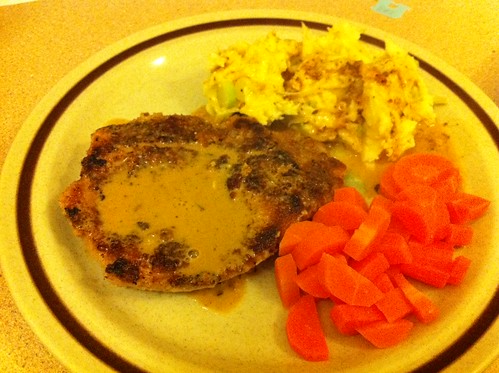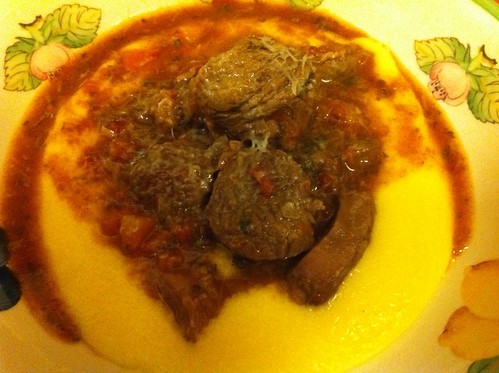Apologies for the colour issues in this photo! I’ll stop taking pictures with a camera phone!
Another foray into a rogue cooking magazine, another quick supper.
This time it’s the April 2011 UK Delicious, brought as a present by my best mate when she visited for a couple of weeks earlier in the year. The recipe comes from the “Shortcut suppers” section, which makes use of various store cupboard standbys and ready made bits and pieces.
This recipe is so simple I’d suggest that only the laziest of cooks would need to resort to store bought mash or sauce.
Now, the recipe calls for “pork loin medallions”. I wasn’t sure what this translated to in Australian (although I have found Australian recipes using the same terminology), but my butcher sells what he calls “pork schnitzels” which are vaguely round, reasonable thin pieces of pork (they’ve not been put through the tenderiser or crumbed). Basically, you’re looking for a piece of meat that will cook quickly, that is lean and is without bone.
To cook the pork, dip the medallions in egg and then crumb with a mixture of breadcrumbs, finely grated parmesan cheese, pepper and herb of your choice (sage, thyme or oregano will all work well). Pan fry (in plenty of hot oil) until cooked and the topping is golden and crispy.
Remove the meat from the pan and keep warm.
As there’s no Waitrose for any of us to nip to for the cider and mustard sauce you have to make your own. Fortunately, this isn’t difficult: remove the pork from the pan and deglaze with either dry cider or white wine. Add a teaspoon of grainy or Dijon mustard (I prefer grainy, as I find Dijon can be a little too vinaigery), stir well and finish with some cream. Allow it to thicken a little and … sauce done!
Serve with a quick colcannon. In advance, pan fry a finely sliced leek and some finely sliced white cabbage until soft. Make mash your usual way and mix through the greens. This is great way of making mash a bit more interesting, as well as getting a few extra veggies on your plate.
All too easy and this makes an interesting meal out of relatively simple ingredients. Just remembering to add some parmesan cheese to breadcrumbs is enough to jazz up pretty much anything you end up crumbing in future!



